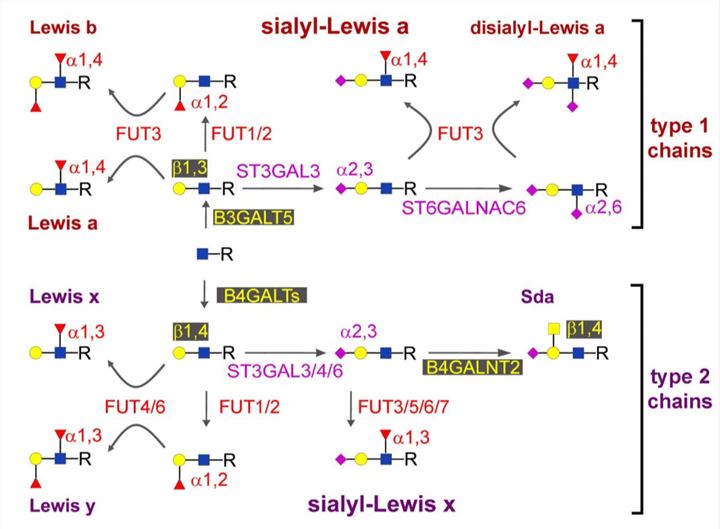With years of experience and expertise in antibody development, Creative Biolabs is an indispensable partner that is able to provide integrated antibody development services to support your in vitro diagnostic (IVD) kit development. We focus on the discovery of new, highly sensitive and specific marker for different diseases, including cancers. Especially, sialyl Lewis X (CSLEX) has been recognized as a compelling biomarker that may serve as an indicator of prognosis of lung cancer.
Introduction of CSLEX
Carbohydrate antigens (CAs) are classified into type I (sialyl Lewis A, sLea) or type II (sialyl Lewis X, sLex) antigens based on structure. Type I antigens possess the structure of NeuAcα2→3βGalβ1→3(Fucα1→4) GlcNAcβ1→3Galβ→4Glc→R, and are associated with the Lewis blood type. In contrast, type II antigens possess the structure of NeuAcα2→3Galβ1→4(Fucα1→3) GlcNAcβ1→3Galβ1→4Glcβ1→R, which is not affected by the Lewis blood type. Both are fucosylated tetrasaccharides and only differ in the position of the fucose linkages.
 Fig.1 Structure and biosynthesis of Lewis antigens.1
Fig.1 Structure and biosynthesis of Lewis antigens.1
CSLEX, also known as stage-specific embryonic antigen 1 (SSEA-1), and cluster of differentiation 15s (CD15s), is a type II carbohydrate antigen that plays a key role in cell adhesion and cell recognition. It is composed of a fucose and an N-acetyllactosamine, and its synthesis depends on the activity of enzymes α(1,3/1,4) fucosyltransferase (FucT-III). CSLEX is a ligand for the selectin expressed by endothelial cells, mediating the extravasation of neutrophils into sites of injury or infection. It is observed on leukocytes and cancer cells and binds to selectins during inflammatory processes and early metastasis. CSLEX is also one of the most important blood group antigens and is displayed on the terminus of glycolipids on the cell surface.
CSLEX Marker for Lung Cancer
Lung cancer is the most common cancer worldwide, resulting in more deaths per year than other cancers. It has a poor prognosis with a 5-year survival rate of 15% and is generally diagnosed in the late stages. It is valuable to explore biomarkers derived from sputum, serum, and tissue for the early diagnosis of cancer. CSLEX is known to be expressed in normal tissues and various human cancers and primary tumors, including lung, breast, and stomach cancers.
Cell surface carbohydrates are involved in many biological processes, including cellular proliferation, differentiation, maturation, and malignant transformation. Dramatic changes in carbohydrates are correlated with cancer occurrence, tumor invasiveness, and metastatic behavior. The potential role of CSLEX in the tumor has been supported by clinical studies, the expression of which is significantly higher on metastatic cancer cells and can be exploited by cancer cells to help metastasis. The findings by St Hill et al. (2011) showed that in lung carcinomas, 71% of tumors were highly positive for CSLEX expression in regions of increased neutrophil infiltration. Thus, it may represent a marker for monitoring the progression of lung cancer.
IVD Antibody Development Service for CSLEX Marker
High levels of CSLEX on serum glycoproteins and expressions of CSLEX epitope on tumor tissue are related to a poor outcome. It is a good prognostic indicator of the stage of the disease and is proposed as a useful indicator of tumor progression, but a poor marker for disease diagnosis. At Creative Biolabs, we provide high-quality IVD antibody development services against CSLEX to offer high-sensitivity and high-specificity antibodies for IVD kit development. We also offer specialized diagnostic immunoassay development services to our clients. Our services are customized to suit their specific requirements.
Creative Biolabs has accumulated abundant experience from the accomplishment of many challenging projects. If you’re interested in our services, please contact us for more information or directly send us an inquiry.
Reference
- Trinchera, Marco, Adele Aronica, and Fabio Dall’Olio. "Selectin ligands Sialyl-Lewis a and Sialyl-Lewis x in gastrointestinal cancers." Biology 6.1 (2017): 16. Distributed under Open Access license CC BY 4.0, without modification.
For Research Use Only.

